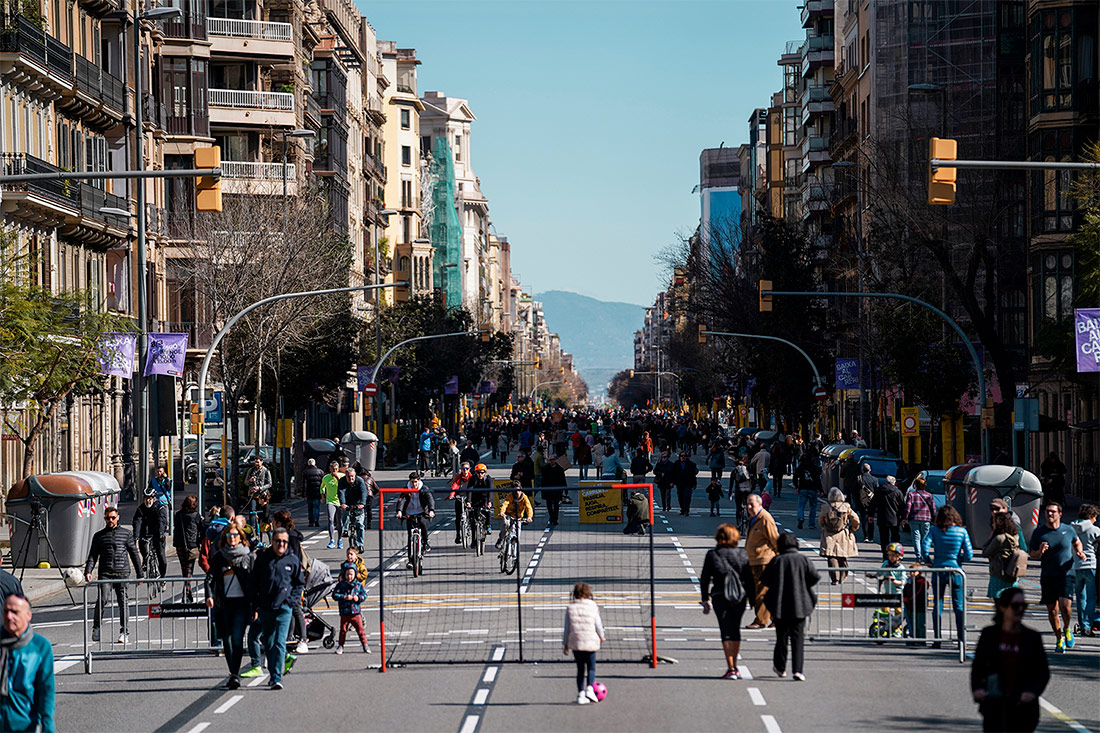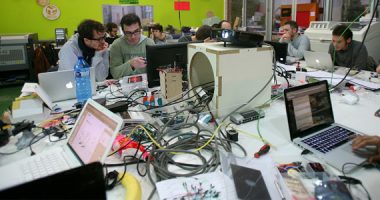
Dan Gunner, Värmlands Museum | Domini públic
The basic structures of our society became obsolete some time ago. The current pandemic only goes to reaffirm that the world that was designed by industrial society is not useful to us for tackling the challenges of the present. For this reason, it is necessary to rethink schools, political parties, trade unions, the city, and hospitals. And beyond technological change, it is necessary to modify relationships and processes.
In the beginning was the interface
Whenever somebody says the word interface one immediately thinks of a keyboard, a mouse or a joystick, and an infinite number of icons on a screen… This interface – also called a graphical user interface – is a place for interaction, the frontier space where the analogical (double-clicking the mouse) becomes digital (a file, made up of bits, opens). But the graphical user interface is not limited to that exchange between individual and technology: that relationship is mediated by an “interaction grammar” that, in order that things function, must be shared between designer and user.
This idea – the interface understood as a network of actors that are human (user, designer, etc.), technological (mouse, keyboard, screen, apps, Internet, etc.) and institutional (interaction grammar, businesses, laws, etc.) – can be taken far beyond the classical image of the individual against the digital machine. If we scale the concept, we can consider the school as an interface where actors that are human (teachers, students, governors, families, etc.), technological (blackboards, benches, books, pencils, projectors, tablets, etc.) and institutional (school management, PTA, Department of Education, Ministry, etc.) maintain different types of relationships with each other and carry forward a series of processes.
Educational interfaces
For years there has been talk of a “crisis in the school system” and of “educational innovation”. Rivers of ink and seas of bits have issued forth on this question in recent years. Back in 2007, in an article published in La Vanguardia, Manuel Castells warned: “The idea that young people today should bear the burden of a rucksack full of boring textbooks, defined by ministerial bureaucrats, and should be locked up in a classroom to endure a discourse irrelevant to their perspective, and should put up with all this in the name of the future, is simply absurd”. For some, the solution simply involves incorporating “educational technology” into the classroom and training the teachers. However, for others, we believe that the issue is much more complex and that it demands another type of focus. Perhaps a view from the perspective of interfaces might be useful for us.
However, why is the school such a backward educational interface that is not in tune with the society of the 21st century? The compulsory state school, as we know it, was created in the 18th century in Prussia to educate citizens and, passing through the industrial and French revolutions en route, it gradually incorporated new values and functions. This interface designed for an industrial society – its main mission was to train the labour force in a homogeneous way and discipline it – had holes everywhere. It is almost obvious: an educational interface designed for the industrial society cannot work in a post-industrial society. COVID-19 has done nothing if not place in evidence the limitations of this educational interface, created three centuries ago.
The lockdown has forced schools to change, in a few days, to an online learning system and to exploiting whatever digital resources that they had to hand. This situation is common across most countries, above all those in Mediterranean Europe and Latin America: neither actors nor humans were prepared for this landscape. With respect to the technological actors, in these weeks of confinement there has been a cruel return of the old debate on the “digital divide”. Even in Barcelona we have found students who do not have a connection in their homes and who have had to “leech” their neighbours’ Wi-Fi in order to follow classes via Zoom.
It is interesting to note that, what in the everyday life of individual pupils would be normal – I am referring to passing from the “digital world” to the “real world” and back again by the new generations – has presented so many problems when taken to the institutional scale, from an unbearable workload for all actors to an enormous lack of comprehension regarding what the pedagogic dynamics should be in a digitalised environment.
Although universities were born before state schools (at the end of this century, the oldest among them will be celebrating their one-thousandth birthday), they are not immune to these transformations and tensions. The amazing thing is that even the innovations that had been introduced into universities before the pandemic must also be reoriented. An example: less than a year ago, in the Communication Faculty of the Pompeu Fabra University (UPF) in Barcelona, we inaugurated some spaces for co-working and group work for projects. A few days ago, at a meeting with colleagues, it was already accepted that these innovative spaces would have to be adapted to the “new normal”. And the same thing will have to be done with all other educational and cultural interfaces: classrooms, laboratories, bookstores, museums, and exhibition centres, will all have to be redesigned to be able to continue functioning in a society that is doubly “post”: post-industrial and post-pandemic.
The interfaces of Modernity
Many other interfaces that were already showing their limitations from a couple of decades ago, such as political interfaces (parties) or social interfaces (trade unions), must pass through processes of redesign if we want them to continue fulfilling their representative roles. COVID-19 has added hospitals and healthcare centres to this list: during the worst weeks of the pandemic, these interfaces had to be redesigned in real time in order to tackle the boom in the number of patients entering their emergency departments.

Street closed in Barcelona during the Obrim Carrers initiative | © Barcelona City Council
Another interface that will not escape redesign is the city. Urban interfaces will have to be rethought in all their dimensions, from the relationship between the public and the private space to the spaces for the flow and permanence of pedestrians while maintaining a “safe social distance”. Even highly innovative spaces on an urban level, such as the “super-blocks” of Barcelona or the new co-working rooms at the UPF, are not prepared for the post-pandemic world and will have to be redesigned.
Nearly all the interfaces that have been mentioned (compulsory state schools, political parties, trade unions, hospitals) were created during Modernity to cater for the needs of a type of industrial mass society that is in the process of disappearing. COVID-19 has done nothing if not slit open all of these interfaces and evidence their incapacity to tackle an increasingly complex and uncertain world.
What can we do to counter this obsolescence? The road that is taking shape is quite clear: it is necessary to redesign these interfaces. And if we consider that these are complex networks of human, technological, and institutional actors, it should also become clear that it is not sufficient to simply change (or substitute) one technological actor with another: what is necessary is to change the weave of relationships and processes that make up the interface. The technological actors can facilitate the change or, to the contrary, end up reproducing the traditional functioning of an interface. In other words, it is not sufficient to introduce a digital blackboard into the classroom to change an educational interface, in the same way that the electronic vote will not eliminate, as if by magic, the miseries of the political parties.
The form that the “new normal” adopts will depend largely on the character of these design macroprocesses and the level of participation that they allow citizens. How will the redesign of these interfaces look? Will it be a top-down design, marked by a convergence of interests among the large corporations and some sectors of the State. Or a bottom-up process, one that is participatory and open? The redesigning of interfaces is an urgent task that should be undertaken without further delay. As I write this text, the governor of New York, Andrew Cuomo, has just written to the former CEO of Google, Eric Schmidt, to help them invent a post-pandemic future and join Bill Gates, who is already “re-imagining education”, in a digital key so that schools can open in the autumn.




Edgardo | 16 July 2020
Excelente artículo
Carlos Cosials | 21 August 2020
Felicidades, Scolari y un saludo,
Hace tiempo que no leía un reflexión tan interesante, por la perspectiva sistémica que planteas (de actores/nodos e interfaces/relaciones).
Voy a compartirlo….
Maria Leonida | 23 August 2020
Very good concept and well written!
Leave a comment